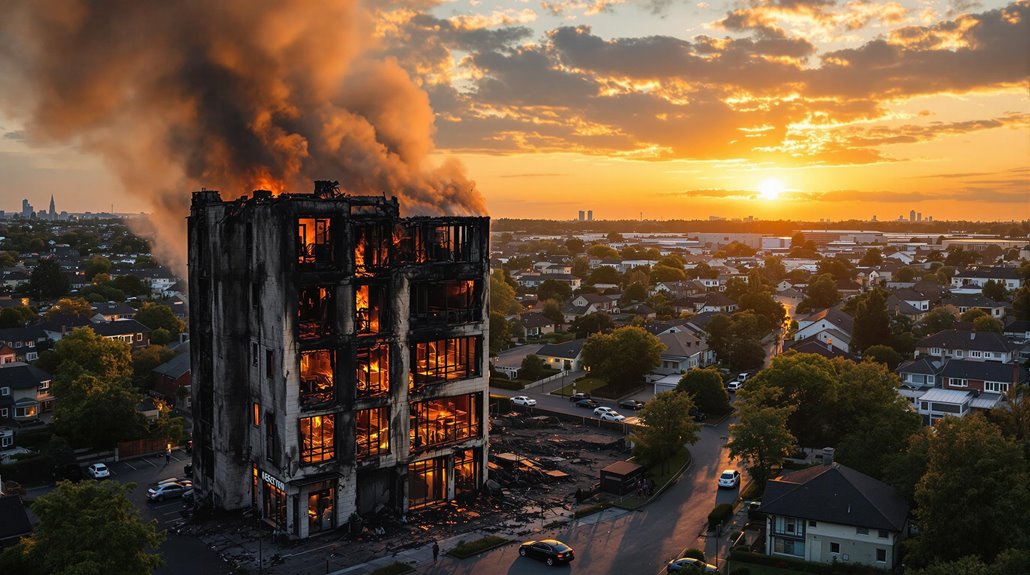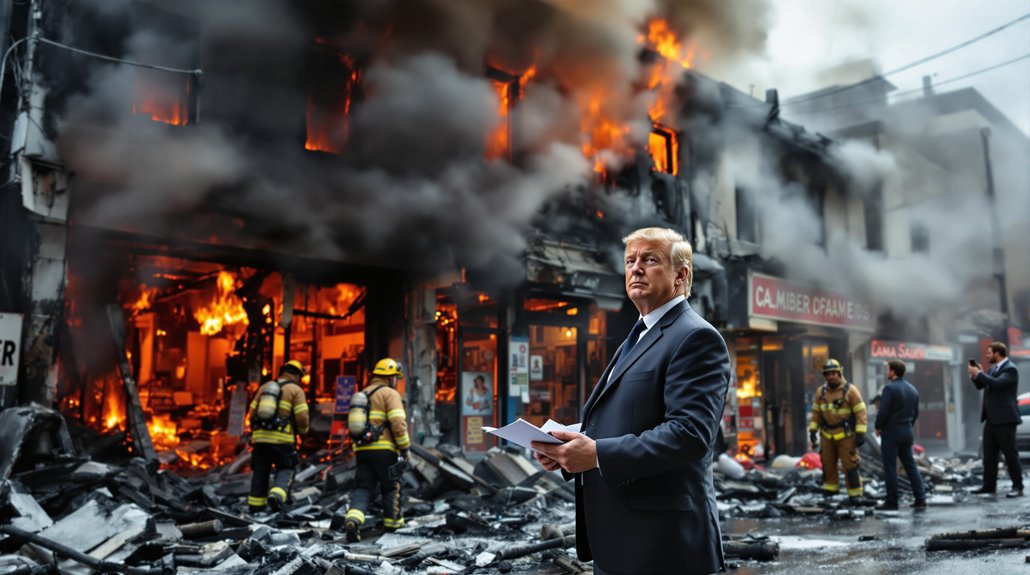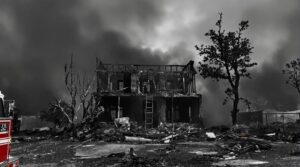Fire insurance is a crucial risk management tool offering financial protection against fire damage. It aids in mitigating property and financial losses by covering repair, replacement, and reconstruction costs. Extensive policies include living expenses for temporary lodging and legal liability coverage. Key components are actual cash value, replacement cost, and claim documentation. Fire insurance guarantees rapid recovery for homeowners and operational continuity for businesses. To explore ideal strategies for maintaining financial resilience, further insights are available.
Key Takeaways
- Fire insurance provides financial coverage for repair, replacement, and reconstruction after fire damage.
- It protects property owners from financial devastation by covering unexpected fire-related expenses.
- The policy includes legal liability protection and covers third-party damages and legal defense costs.
- It ensures operational continuity for businesses by covering interruption losses and damages.
- Fire insurance policies often include living expenses for temporary lodging during recovery.
Understanding Fire Insurance and Its Role
Fire insurance serves as an essential risk management tool for property owners, offering a safety net against financial devastation caused by fire-related incidents. It mitigates property loss by providing financial coverage for repair, replacement, and reconstruction expenses. In 2022, the U.S. witnessed 374,300 residential fires, resulting in $10.8 million in damages, underscoring the crucial role of fire insurance in offsetting such extensive costs. Standard homeowners insurance policies typically provide basic fire coverage; however, additional fire insurance can be procured to enhance protection against unforeseen fire events. This thorough coverage often extends beyond direct fire damage to include collateral impacts such as smoke and water damage from firefighting efforts. For those committed to serving others, understanding fire insurance is essential in ensuring the continuity of operations and preventing financial crippling. It is a strategic investment for safeguarding assets, maintaining stability, and supporting a swift recovery post-incident. Working with public insurance adjusters can significantly increase settlement amounts and ensure fair compensation for fire-related claims.
Financial Protection Against Fire Damage
In the domain of risk management, understanding the intricacies of financial protection against fire damage is paramount for both homeowners and businesses. Fire insurance provides essential coverage to mitigate financial loss resulting from fire incidents, which are statistically frequent and costly, with over 374,300 residential fires causing approximately $10.8 million in damages annually in the U.S. Such insurance coverage includes rebuilding expenses and property replacement, ensuring substantial financial recovery. A critical component is the choice between Actual Cash Value (ACV) and Replacement Cost coverage. Replacement Cost policies offer full reimbursement for new items, facilitating a more thorough recovery. In addition, policies often cover living expenses, such as temporary lodging and meals, maintaining financial stability during the recovery period. Consequently, fire insurance provides not only a safeguard against sudden financial burdens but also peace of mind, empowering individuals and businesses to focus on rebuilding and serving their communities effectively. Working with public adjusters throughout the claims process can significantly increase the likelihood of receiving higher settlements for fire-related damages.
Coverage for Residential and Commercial Properties

Fire insurance is a critical component in safeguarding both residential and commercial properties, offering financial protection against the myriad risks associated with fire-related incidents. For residential properties, standard homeowners insurance typically encompasses fire damage; however, high-value or uniquely constructed homes may necessitate supplemental fire insurance to mitigate potential losses effectively. In the commercial sector, fire insurance plays a pivotal role by covering not only damages to physical structures and inventory but also addressing business interruption losses, thereby ensuring operational continuity post-incident. Proper claims documentation is essential when filing for fire-related damages, requiring detailed evidence to support the compensation process.
Residential Property Protection
When evaluating the importance of residential property protection, the potential financial devastation caused by fire incidents necessitates extensive fire insurance coverage. With over 374,300 residential fires in 2022 leading to approximately $10.8 million in damages, the need for robust property insurance is evident. Fire insurance not only covers structural loss or damage but also extends to personal possessions, ensuring rapid recovery for affected families. Additionally, many policies provide for additional living expenses, essential when temporary relocation is necessary due to uninhabitable conditions. Public insurance adjusters can help homeowners navigate complex claims processes to ensure fair compensation for fire-related damages.
- Comprehensive Coverage: Protects both structure and personal belongings.
- Financial Safeguard: Mitigates repair or replacement costs.
- Rapid Recovery: Facilitates quick return to normalcy.
- Temporary Housing Assistance: Covers costs when relocating is unavoidable.
Commercial Property Coverage
Commercial property coverage, an essential component of risk management for businesses, safeguards financial stability in the aftermath of fire-related incidents. Commercial fire insurance encompasses protection for building structures, inventory, and equipment, enabling businesses to recover without substantial financial strain. Insurance covers not only physical damages but also extends to additional living expenses, facilitating business continuity by compensating lost income and ongoing costs during repair periods. Legal liabilities to third parties are also mitigated, protecting businesses from potential lawsuits. Tailored coverage options address specific risks, particularly for high-fire-risk areas or industries handling flammable materials. Regular assessment of property value and coverage limits is imperative, as underinsurance can result in significant financial detriment, undermining recovery efforts post-incident. Understanding standard policy exclusions helps businesses identify potential coverage gaps and determine if additional insurance riders are necessary.
Ensuring Business Continuity After a Fire
In the domain of risk management, guaranteeing business continuity following a fire requires strategic planning and robust fire insurance coverage. Fire insurance is indispensable for businesses aiming to safeguard their future operations. Extensive insurance policies include coverage for damaged property, lost profits, and ongoing expenses, thereby enabling a swift recovery process. Statistics indicate that 30% of small businesses without adequate coverage cease operations within a year post-fire, underscoring the importance of such financial protection.
Coverage for business interruption is essential, as it provides necessary funds for temporary relocation and operational costs during restoration. This financial buffer facilitates uninterrupted service delivery, maintaining the trust and reliance of clients and stakeholders. Businesses that invest in thorough fire insurance are better equipped to withstand fire-related disruptions and guarantee continuity.
- Fire insurance aids in rapid recovery by covering damaged property.
- Business continuity is supported through coverage of lost profits.
- Insurance policies include business interruption funds.
- A strategic insurance plan mitigates financial impact.
Working with licensed public adjusters can significantly increase settlement amounts and ensure businesses receive fair compensation for their fire-related losses.
Legal Liability and Third-Party Damages

As fire hazards pose significant threats to property owners, the importance of fire insurance in managing legal liability and third-party damages cannot be overstated. Fire insurance acts as an essential risk management tool, protecting property owners from the legal complexities and financial burdens associated with third-party damages. When a fire spreads beyond the insured premises, it has the potential to inflict damage on neighboring structures or cause injury to individuals, resulting in legal liability for the property owner. Coverage often extends to legal defense costs, ensuring that policyholders are not financially imperiled by litigation. In the U.S., negligent actions leading to fires can render property owners liable, making fire insurance indispensable for mitigating legal claims. The National Fire Protection Association (NFPA) reported $14.8 billion in property damage in 2021, emphasizing the financial risks without adequate coverage. Consequently, fire insurance serves to safeguard against unexpected legal judgments or settlements. While standard homeowners policies typically include fire coverage, properties in high-risk zones may require additional documentation and specialized coverage options for comprehensive protection.
Key Components of Fire Insurance Policies
The foundational elements of a fire insurance policy encompass coverage and exclusions, which delineate the scope of protection against fire-related perils and specify any limitations or scenarios not covered by the policy. Premiums are determined based on risk assessment factors such as property location, construction materials, and safety features, influencing the cost and terms of the policy. Understanding these components is critical for policyholders to guarantee adequate coverage without unexpected financial exposures. Regular maintenance records can help strengthen fire-related claims and potentially reduce insurance premiums over time.
Coverage and Exclusions
While fire insurance serves as a critical safeguard against financial loss, understanding its coverage and exclusions requires meticulous attention to detail. Coverage typically encompasses fire-related losses from accidental causes, including electrical faults, lightning, and gas explosions. However, policyholders must be acutely aware of exclusions, such as damages from arson, negligence, and intentional acts, which are deemed fraudulent. Coverage limits may also extend to smoke and water damage resulting from firefighting efforts, enhancing protection. Working with public insurance adjusters can increase claim settlements by 30-50% through recoverable depreciation coverage.
- Coverage includes accidental fires and related incidents.
- Exclusions often involve fraudulent or negligent acts.
- Reimbursement methods like Actual Cash Value and Replacement Cost determine compensation.
- Loss of use provision covers temporary expenses if the property is uninhabitable.
Such awareness guarantees policyholders can navigate their fire insurance effectively, optimizing the benefits of their coverage.
Premium and Policy Terms
Understanding the premium and policy terms of fire insurance policies is essential for evaluating potential risks and financial implications. The premium is calculated based on property value, location, and specific risks, directly affecting the cost of coverage. Policy terms delineate coverage specifics, exclusions, and applicable deductibles, guiding the claims process. The sum insured defines the maximum payout, safeguarding policyholders against significant financial loss. Differentiating Actual Cash Value (ACV) from Replacement Cost is vital; ACV accounts for depreciation, whereas Replacement Cost provides full replacement value. Customizable options within policies enable tailored coverage for unique risks or valuable items, ensuring thorough protection. By analyzing these components, individuals can make informed decisions, aligning coverage with personal needs and community service objectives. Similar to homeowners insurance, named peril policies specifically outline covered hazards like fire and theft, making them a common choice for fire protection.
Comparing Fire Insurance Options

How does one discern the ideal fire insurance policy amidst a myriad of options? A thorough evaluation involves understanding coverage limits to guarantee they safeguard the full value of property and possessions. Policies usually cover a percentage of this value, making it essential to examine these limits meticulously. In addition, individuals should scrutinize the inclusion of additional living expenses coverage, which can provide financial relief for temporary housing if a residence becomes uninhabitable due to fire damage.
Attention to the claims process is paramount; a streamlined approach can substantially reduce recovery time post-incident. Moreover, awareness of policy exclusions is crucial, as many do not cover damages from negligence, arson, or specific natural disasters.
To efficiently compare options, utilizing online tools can provide clarity and facilitate the selection of extensive coverage at competitive premiums. Here are key considerations:
- Evaluate specific coverage limits
- Assess additional living expenses coverage
- Investigate claims process efficiency
- Understand policy exclusions
Strategies for Reducing Fire Insurance Premiums
Reducing fire insurance premiums can be strategically achieved through several key measures rooted in risk mitigation and policy optimization. Installing fire safety measures such as smoke detectors and sprinkler systems is a fundamental step, offering significant discounts on fire insurance policies, often between 5% to 20%. Insurers recognize these improvements as reducing potential fire risks. Regular maintenance of electrical wiring and heating systems further lowers risk, thereby decreasing premiums due to perceived reduced hazard.
Additionally, bundling fire insurance with other policies like auto or homeowners insurance can result in multi-policy discounts, potentially exceeding 10%. Another strategy involves raising the deductible on a fire insurance policy to lower premiums, though the deductible should remain manageable for policyholders. Finally, conducting an extensive property risk assessment identifies vulnerabilities, allowing for targeted safety enhancements. These improvements not only augment fire safety measures but also contribute to optimizing insurance premiums.
Frequently Asked Questions
What Are the Benefits of Fire Insurance?
Fire insurance coverage offers essential fire damage protection by mitigating financial risks associated with property loss. Understanding fire insurance premiums helps manage costs effectively, ensuring thorough risk assessment and continuity for individuals and businesses dedicated to community service and resilience.
Why Do People Buy Fire Insurance?
Individuals purchase fire insurance to guarantee financial security and property protection. The fire insurance necessity stems from thorough risk assessment, providing coverage for damages and mitigating potential financial burdens associated with fire-related incidents, including restoration and living expenses.
What Is the Importance of Insurance?
Insurance acts as a financial safety net, providing financial security and effective risk management. It offers peace of mind, akin to a lighthouse guiding through stormy seas, ensuring individuals and businesses navigate potential financial pitfalls securely.
What Type of Loss Can Be Compensated by Fire Insurance?
Fire insurance compensates for property damage including structural, contents, smoke, and water damage. It provides financial security through risk assessment, covering accidental fires from electrical faults, gas explosions, and lightning, ensuring extensive protection for homeowners' peace of mind.








